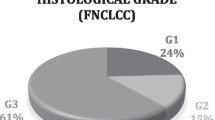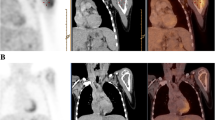Abstract
The effective management of patients with sarcomas requires accurate diagnosis and staging. Imaging, such as ultrasonography (US), computed tomography (CT), magnetic resonance imaging (MRI) are the most freqently used methods for the detection of the lesion location, size, morphology and structural changes to adjacent tissues; however, these modalities provide little information about tumour biology. MRI is a robust and useful modality in tumour staging of sarcomas, however metabolic-fluorodeoxyglucose positron emission tomography/ computer tomography (18F–FDG PET/CT) provides greater accuracy to overall staging in combination with MRI [1]. The advantages of 18F–FDG PET/CT method compared with CT and MRI is that it provides a whole body imaging, maps the viability of the tumour or the metabolic activity of the tissue. Additionally, PET detects the most agressive part of the tumour, demonstrates the biological behaviour of the tumour and therefore has a predictive value. Little data ara available on the role of 18F–FDG PET/CT in the management of sarcomas. The present manuscript aims to provide a review of the major indications of 18F–FDG PET/CT for diagnosis, staging, restaging and monitoring response to therapy and to compare its usefulness with the conventional imaging modalities in the management of patients with sarcomas.

Similar content being viewed by others
References
Faizi NA, Thulkar S, Sharma R et al (2012) Magnetic resonance imaging and positron emission tomography-computed tomography evaluation of soft-tissue sarcoma with surgical and histopathological corelation. Indian J Nucl Med 27(4):213–220
Demetri GD, Antonia S, Benjamin RS et al (2010) Soft-tissue sarcoma. J Natl Compr Cancer Netw 8(6):630–674
Stiller CA, Trama A, Serraino D et al (2013) Descriptive epidemiology of sarcomas in Europe: report from the RARECARE project. Eur J Cancer 49(3):684–695. https://doi.org/10.1016/j.ejca.2012.09.011
Guillou L, Coindre JM, Bonichon F et al (1997) Comparative study of the National Cancer Institute and French Federation of Cancer Centers Sarcoma Group grading systems in a population of 410 adult patients with soft-tissue sarcoma. J Clin Oncol 15:350–362
von Mehren M, Randall LR, Benjamin RS, et al Soft Tissue Sarcoma. NCCN Clinical Practice Guidelines in Oncology (NCCN Guidelines). Version 1.2017 https://www.nccn.org/professionals/physician_gls/pdf/sarcoma.pdf
The European Society for Medical Oncology (ESMO) Sarcoma Network Working Group (2014) Soft-tissue and visceral sarcomas: ESMO Clinical Practice Guidelines for diagnosis, treatment and follow-up. Ann Oncol 25(3):102–112. https://doi.org/10.1093/annonc/mdu254
Borbély K (1999) A pozitron emissziós tomográfia helye a korszerű betegvezetésben. Orv Hetil 140:171–178
Borbély K, Szilágyi I, Kásler M (2011) IV. PET/CT Multidiszciplináris Nemzeti Konszenzus Konferencia Állásfoglalása. Mag Onkol 55(2):117–127
Wang X, Jacobs M, Fayad L (2011) Therapeutic response in musculosceletal soft-tissue sarcomas: evaluation by magnetic resonance imaging. NMR Biomed 24(6):750–763
Lin X, Davion S, Bertsch EC, Omar I, Nayar R, Laskin WB (2016) FNCLCC grading of soft-tissue sarcomas on needle core biopsies using surrogate markers. Hum Pathol 56:147 PubMedView ArticleGoogle Scholar
Schwarzbach MH, Dimitrakopoulou-Strauss A, Willeke F et al (2000) 18-F fluorodeoxy-glucose positron emission tomography imaging in soft-tissue sarcomas. Ann Surg 231:380–386
Volker T, Denecke T, Steffen I et al (2007) Positron emission tomography for staging of pediatric sarcoma patients: results of a prospective multicenter trial. J Clin Oncol 25(34):5435–5441
Aoki J, Watanabe H, Shinozaki et al (2001) T FDG PET of primary benign and malignant bone tumours: standardized uptake value in 52 lesions. Radiology 219:774–777
Borbely K, Szilágyi I, Kasler M (2011) IV. PET/CT Multidiszciplinaris Nemzeti Konszenzus Konferencia Allasfoglalasa (2011) Magyar Onkológia 55 (2):117–127
Franzius C, Sciuk J, Daldrup-Link HE et al (2000) FDG-PET for detection of pulmonary metastases from malignant primary bone tumours: comparison with bone scintigraphy. Eur J Nucl Med 27:1305–1311
O’Sullivan GJ, Carty FL, Cronin CG (2015) Imaging of bone metastasis: an update. World J Radiol 7(8):202–211
Liangjun R, Zhen Z, Zhifeng C et al (2016) 18F-Labeled NaF PET-CT in detection of bone metastases in patients with preoperative lung cancer medicine. Medicine 95(16):1–6
Sampath SC, Sampath SC, Mosci C et al (2015) Detection of osseous metastasis by 18F NaF/18F F-FDG PET/CT versus CT alone. Clin Nucl Med 40(3):e173–e177
Schwab JH, Boland PJ, Antonescu C et al (2007) Spinal metastases from myxoid liposarcoma warrant screening with magnetic resonance imaging. Cancer 110:1815–1821
Adler LP, Blair HF, Makley JT et al (1991) Noninvasive grading of musculoskeletal tumours using PET. J Nucl Med 32(8):1508–1512
Ioannidis JP, Lau J (2003) 18F-FDG PET for the diagnosis and grading of soft-tissue sarcoma: a meta-analysis. J Nucl Med 44:717–724
Kwee TC, Cheng G, Lam MG, Basu S, Alavi A (2013) SUV of 2.5 should not be embraced as a magic threshold for separating benign from malignant lesions. Eur J Nucl Med Mol Imaging 40(10):1475–1477
Hawkins DS, Schuetze SM, Butrynski JE et al (2005) [18F] Fluorodeoxyglucose positron emission tomography predicts outcome for Ewing sarcoma family of tumours. J Clin Oncol 23:8828–8834
Schuetze SM, Rubin BP, Vernon C et al (2005) Use of positron emission tomography in localized extremity soft-tissue sarcoma treated with neoadjuvant chemotherapy. Cancer 103:339–348
Evilevitch V, Weber WA, Tap WD et al (2008) Reduction of glucose metabolic activity is more accurate than change in size at predicting histo-pathologic response to neoadjuvant therapy in high-grade soft-tissue sarcomas. Clin Cancer Res 14:715–720
Machulla HJ, Blocher A, Kuntzsch M et al (2000) Simplified labeling approach for synthesizing 3′-deoxy-3′-[18F] fluorothymidine ([18F] FLT). J. Radioanal. Nucl. Chem. 243(3):843–846
Tateishi U, Kawai A, Hirokazu C et al (2011) PET/CT allows stratification of responders to neoadjuvant chemotherapy for high grade sarcoma: a prospective study. Clin Nucl Med 36(7):526–532
Enzinger FM (1970) Epithelioid sarcoma: a sarcoma stimulating a granuloma or a carcinoma. Cancer 26:1029–1041
Sanghera B, Wong WL, Sonoda L et al (2014) FLT PET-CT in evaluation of treatment response. Indian J Nucl Med Apr-Jun 29(2):65–73
Buck AK, Halter G, Schirrmeister H et al (2003) Imaging proliferation in lung tumours with PET: 18F-FLT versus 18F-FDG. J Nucl Med 44:1426–1431
Buck AK, Bommer M, Stilgenbauer S et al (2006) Molecular imaging of proliferation in malignant lymphoma. Cancer Res 66:11055–11061
Herrmann K, Buck AK, Schuster T, Junger A, Wieder HA, Graf N et al (2011) Predictive value of initial 18F-FLT uptake in patients with aggressive non-Hodgkin lymphoma receiving R-CHOP treatment. J Nucl Med 52(5):690–696
Yamamoto Y, Ono Y, Aga F et al (2012) Correlation of 18 F-FLT uptake with tumour grade and Ki-67 immunohistochemistry in patients with newly diagnosed and recurrent gliomas. J Nucl Med 53(12):1911–1915
Contractor KB, Kenny LM, Stebbing J, Rosso L, Ahmad R, Jacob J et al (2011) [18F]-3′deoxy-3′-fluorothymidine positron emission tomography and breast cancer response to docetaxel. Clin Cancer Res 17(24):7664–7672
Buck AK, Hermann K, Büschenfelde CM et al (2008) Imaging bone and soft-tissue tumours with the proliferation marker [18F] fluorodeoxythymidine. Clin. Cancer Res. 14(10):2970–2977
Benz MR, Czernin J, Allen-Auerbach MS (2012) 3′-deoxy-3′-[18F] fluorothymidine positron emission tomography for response assessment in soft-tissue sarcoma: a pilot study to correlate imaging findings with tissue thymidine kinase 1 and Ki-67 activity and histopathologic response HHS Author Manuscript Cancer 118 (12):3135–3144
Been LB, Suurmeijer AJ, Elsinga PH, Jager PL, van Ginkel RJ, Hoekstra HJ (2007) 18F-fluorodeoxythymidine PET for evaluating the response to hyperthermic isolated limb perfusion for locally advanced soft-tissue sarcomas. J Nucl Med 48:367–372
Jerabek PA, Patrick TB, Kilbourn MR, Dischino DD, Welch MJ (1986) Synthesis and biodistribution of of 18F-labeled fluoronitroimidazoles: potential in vivo markers of hypoxic tissue. Int J Rad Appl Instrum Part A 37:599–605
Rajendran JG, Wilson DC, Conrad EU et al (2003) [18F] FMISO and [18F] FDG PET imaging in soft-tissue sarcomas: correlation of hypoxia, metabolism and VEGF expression. Eur J Nucl Med Mol Imaging 30(5):695–704
Borbely K, Zs N, Kasler M (2014) Clinical application 18F-FDG PET/CT in the treatment of sarcomas. Hung Oncol 58(1):24–31
Author information
Authors and Affiliations
Corresponding author
Rights and permissions
About this article
Cite this article
Németh, Z., Boér, K. & Borbély, K. Advantages of 18F FDG-PET/CT over Conventional Staging for Sarcoma Patients. Pathol. Oncol. Res. 25, 131–136 (2019). https://doi.org/10.1007/s12253-017-0325-0
Received:
Accepted:
Published:
Issue Date:
DOI: https://doi.org/10.1007/s12253-017-0325-0




